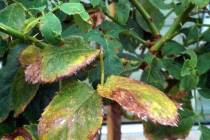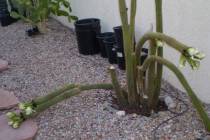Most of the damage done to plants during high summer temperatures was due to a lack of water. And if there are strong winds, they also use more water. The bottom line, if it’s a hot, bright, windy day, it’s time to water now.
- Home
- >> Local
- >> Local Columns
Bob Morris

Bob Morris is a horticulture expert living in Las Vegas and professor emeritus for the University of Nevada. Visit his blog at xtremehorticulture.blogspot.com. Send questions to Extremehort@aol.com.
It is important to select good varieties of vegetables to plant in the fall, and the publications by Dr. Sylvan Wittwer, formerly of Logandale, make some solid, old-fashioned varietal recommendations he has had success growing in this area.
Planting can occur almost 12 months of the year in our climate, but there are times to plant that are better than other times. For the best times, begin planting most trees, shrubs and fruit around the end of September.
Roses do not need daily watering, even during the hottest days. If the soil was prepared correctly at planting time and the soil surface covered in wood chips, they should get watered — at the most during the hottest times — every other day.
Beans, carrots and beets should have been harvest before the weather got hot. These are cool-season crops.
Plant several types of tomatoes rather than focus on one variety. Cherry, grape and pear tomatoes are the easiest to grow and set fruit the easiest.
Nearly 100 in-person classes have quietly been held at Las Vegas Valley campuses since July 1, providing a semblance of educational normalcy. We step inside three of them.
It common for the chitalpa tree to partially defoliate in the summer.
Renewal pruning, cutting deep inside the shrub and removing larger wood, results in a flush of sucker growth from the remaining stubs that will be succulent and produce lots of leaves and flowers.
Plums and pluots improve in flavor when they are kept on the tree longer and harvested closer to their mature date. These fruits are normally harvested from the end of July to the first or second week of August in our climate.
The Chinese pistache is a good choice in the desert as a general landscape, street or lawn tree. It grows to about 30 feet in height.
Sucker removal and how often it’s done depends on the plant, how old it is and how the suckers are removed. Trees sucker more if they don’t get enough water.
Lantanas are easy to grow and can add a variety of colors that attract wildlife including butterflies to home landscapes.
Some plants don’t grow well in rock, and roses are one of them. Nearly all landscape plants in the rose family like soil improvement and a moist environment when planted in desert soils.
Be careful when putting cactuses on an automatic water or irrigation timer. They are watered so infrequently that it sometimes makes sense to water these plants manually with a hose rather than automating the task.






















